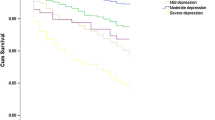Summary
There is very strong evidence in the literature indicating that the presence of subthreshold depressive symptoms is not a benign clinical condition. At least 5 separate investigational groups, including our own, have confirmed that the presence of depressive symptomology not reaching the diagnostic threshold for a DSM-III-R mood disorder diagnosis is correlated with social dysfunction, work impairment and absenteeism, and the potential risk of future episodes of major depression.
We have labelled this condition ‘subsyndromal symptomatic depression (SSD)’. A secondary analysis of the National Institute of Mental Health Epidemiological Catchment Area (ECA) Programme database has demonstrated that SSD has a 1-year prevalence of approximately 8% in the general population. The majority of those with SSD were female (approximately 63%) and they presented with a clinical symptom picture that closely resembled that of major depression. However, it was notable that the feature of 14 days of dysphoria/anhedonia, which is a required criterion for a mood disorder diagnosis in the DSM-III-R system, was absent from these patients. It was also noted that patients with SSD more frequently received social welfare and disability benefits than did the general population without depressive symptoms.
We have concluded that SSD does represent a significant clinical problem that is not covered by any DSM-III, DSM-III-R or DSM-IV mood disorder diagnosis. Furthermore, this disorder is of considerable importance in public health. An ongoing clinical trial is investigating the efficacy of fluoxetine in SSD.
Similar content being viewed by others
References
Diagnostic and statistical manual of mental disorders. 3rd rev. ed. Washington, DC: American Psychiatric Association, 1987
Wells KB, Stewart A, Hays RD, et al. The functioning and well-being of depressed patients: results from the Medical Outcomes Study. JAMA 1989; 262: 914–9
Angst J. Recurrent brief depression. A new concept of depression. Pharmacopsychiatry 1990; 23: 63–6
Angst J, Merikengas K, Scheiddeger P, et al. Recurrent brief depression: a new subtype of affective disorder. J Affect Disord 1990; 19: 87–9
Diagnostic and statistical manual of mental disorders. 4th ed. Washington, DC: American Psychiatric Association. In press
Broadhead WE, Blazer DG, George LK, et al. Depression, disability days, and days lost from work in a prospective epidemiologic survey. JAMA 1990; 254: 2524–8
Johnson J, Weissman MM, Klerman GL. Service utilization and social morbidity associated with depressive symptoms in the community. JAMA 1992; 267(11): 1478–83
Howarth E, Johnson J, Klerman GL, et al. Depressive symptoms as relative and attributable risk factors for first-onset major depression. Arch Gen Psychiatry 1992; 49: 817–23
Judd LL, Rapaport MH, Paulus MP, et al. Subsyndromal symptomatic depression: a new mood disorder? J Clin Psychiatry 1994; 55(4): 518–28
Author information
Authors and Affiliations
Rights and permissions
About this article
Cite this article
Judd, L.L. Subsyndromal Symptomatic Depression. CNS Drugs 1, 399–404 (1994). https://doi.org/10.2165/00023210-199401060-00001
Published:
Issue Date:
DOI: https://doi.org/10.2165/00023210-199401060-00001



